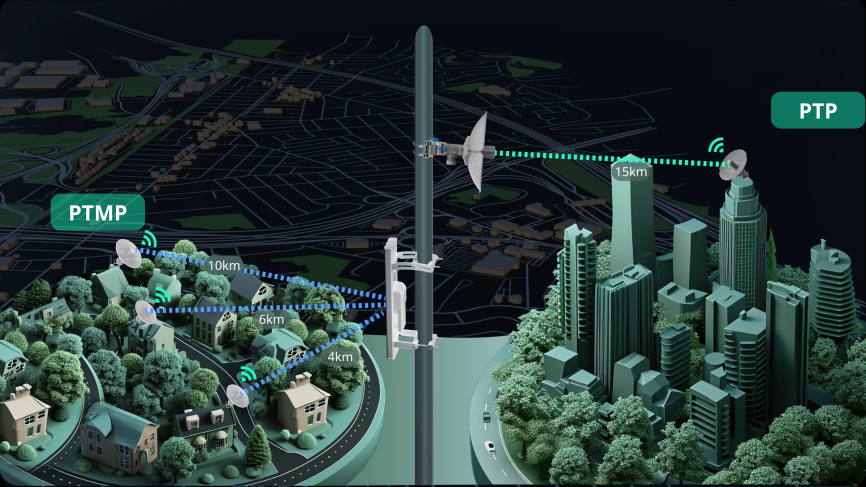Point-to-Point Wi-Fi Bridge is a specific application of wireless bridging technology, falling under the broader concept of Wireless Bridge. Point-to-Point Wi-Fi Bridge is particularly used in scenarios where a stable, high-speed wireless network connection needs to be established between two fixed locations.
Point-to-Point Wi-Fi Bridge Working Principles
Point-to-Point Wi-Fi Bridge uses electromagnetic wave signals as the transmission medium to enable direct wireless connections between two or more fixed wireless devices. It creates a straight-path data transmission channel that allows information to be transmitted between different networks. The working principles are as follows:
- One end of the bridge converts signals from network cables into electromagnetic wave signals and directionally transmits them into the air.
- The bridge at the other end receives the wireless electromagnetic wave signals from the air and converts them back into wired signals, thus achieving connection between two networks.

Point-to-Point Wi-Fi Bridge Application Scenarios
- Long-distance Network Connection: Point-to-Point Wi-Fi Bridge can be used when the distance between two network nodes is significant, or when wired connections are difficult due to terrain, buildings, or other obstacles. For example, connecting local area networks between two different buildings.
- Temporary Network Setup: Point-to-Point Wi-Fi Bridge is an excellent choice when quick network connections are needed without complex wiring work. For instance, setting up networks at exhibitions, events, and other temporary venues.
- Wireless Network Extension: For existing wireless networks, Point-to-Point Wi-Fi Bridge can be used to extend coverage to more distant areas when network expansion is needed.
Point-to-Point Wi-Fi Bridge Advantages and Characteristics
Flexibility: Point-to-point wireless bridging technology is not limited by terrain, buildings, or other obstacles, allowing flexible connections between two network nodes.
Stability: Using high-quality wireless equipment and professional installation techniques ensures the stability and reliability of point-to-point wireless bridging.
High Bandwidth: Modern wireless bridging devices typically support high data transmission rates, meeting the needs of applications such as HD video and large data transfers.
Security: Through encryption and authentication technologies, point-to-point wireless bridging can ensure security and prevent unauthorized access and data leaks.
However, to leverage these advantages, it's essential to choose appropriate and reliable wireless bridging equipment based on actual application scenarios and requirements, and ensure installation locations provide good signal coverage and transmission quality. These processes require professional personnel to provide customized solutions, installation, and debugging services to ensure network stability and performance, with very high requirements for equipment brands. Taking industry leader Ruijie Reyee as an example, the brand has a comprehensive product lineup and a professional team of engineers, capable of providing advanced technology and thorough services. Additionally, Ruijie Reyee's diverse products boast powerful performance and exceptional quality, ensuring stable and high-speed operation even in harsh weather conditions. The company also offers customized solutions based on user-specific needs, ensuring that the configuration meets the required performance standards.

Point-to-Point Wi-Fi Bridge Development Prospects
Thanks to the continuously growing demand for network communication and ongoing technological advancements, the development prospects of Point-to-Point Wi-Fi Bridges are positive.
Market Demand Growth
With the current acceleration of digital transformation and IoT technology, network communication demands across various industries continue to grow. Point-to-Point Wi-Fi Bridge, as an efficient and stable network connection solution, provides long-distance, highly stable network connectivity and serves as an ideal networking solution in special scenarios, indicating significant market potential remains.
Technological Progress and Innovation
As wireless technology continues to evolve, and wireless transmission protocols and algorithms are continually optimized, Point-to-Point Wi-Fi Bridges will further improve transmission speeds, support more high-bandwidth applications, and enhance stability by reducing network interruptions and packet loss. Moreover, further refinement of intelligent management will aid in better network monitoring and fault warning, helping to reduce operational and maintenance costs while improving efficiency.
Policy Support and Promotion
Currently, government departments are increasing investments in network communication infrastructure, promoting the development and application of communication technologies, including Point-to-Point Wi-Fi Bridges. Stronger policy support and international collaboration will provide many conveniences in improving technological capabilities and expanding productivity.
As an efficient and flexible wireless network connection technology, Point-to-Point Wi-Fi Bridge has broad application prospects in long-distance network connections, temporary network setups, and wireless network extension. In practical applications, it's necessary to choose appropriate wireless bridging technology and equipment based on specific needs and scenarios. Opting for advanced technologies and high-performance equipment is crucial to ensuring the long-term, efficient, and stable transmission of data. Of course, as network technologies continue to develop, Point-to-Point Wi-Fi Bridges will need to continuously adapt to emerging technologies such as 5G, IoT, edge computing, and address challenges related to network security. Further innovation and upgrades are also awaited.
Featured Articles
- Networking Tools for Retail Stores: The Core Value of Cloud-Managed APs












